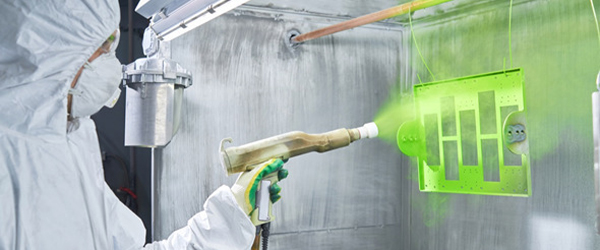
THE PROCESS GENERALLY CONSISTS OF THREE STEPS:
1- The Pre-treatment of the Metal Surface
Powder coating is primarily used in steel, galvanized steel, aluminum, copper and zinc alloy metal surfaces.Metal surfaces are susceptible to rapidly oxidation. To prevent oxidation of the surface is usually oily and greasy which cause several problems for coating. So metal surface should be cleaned by a variety of chemical methods prior to coating methods in order to get the highest performance. Oil, soil, metal oxides, rubber and plastics must be thoroughly removed.
Based on the type of metal used, there are two main methods for the cleaning process;
For choosing of proper process and chemicals, the following points should be determined:
– Metal type and its protective quality requirements
– degree of contamination
– Application area
2- The Powder Coating Application Systems
The most common way of applying the powder coating to metal objects is to spray the powder using an electrostatic gun. Generally, two charging processes are known: corona charging and tribo charging:
– Corona Charging
In corona charging, powder particles are charged by a voltage. An ion field is generated between the electrode and the grounded metal surface. Powder particles passing through this field are charged, and are attracted to the grounded metal. Corona charging is suitable for all kind of powder coat.
Advantages:
– Strong electrostatic field results in rapid charging
– Electrostatic field support the powder particles to move towards the work piece
– Suitable for different types of powder materials
– The differences in particle size distribution can be eliminated
– Film thickness can be simply changed by voltage variations
– Fast color changes and cleaning
– Less equipment wear and replacement of parts
Disadvantages:
Strong electric field induced decrease in ionization
Strong electrostatic field lead to Faraday effect (irregular coating on corners and edges)
Voltage changes lead to Orange peel effect
– Tribo Charging
In Tribo charging, powder particles are charged by friction with the surface of inside the gun. Electrons are removed from the powder particles as they make contact with the gun inside which is typically made of teflon. The positively charged powder particle is transported to the grounded product by the air stream leaving the gun.
Advantages:
– No Faraday effect; corners and edges can be better penetrated
– Uniform coating
– Good flow with no orange peel effect
– Provide very good automation facilities
– does not require a high-voltage generator
Disadvantages:
– Formulation must be adapted to the Tribo charging process; not provide high performance for all type of powder
– Performance is strongly influenced by uncontrolled air-streams
– Particles smaller than 10 microns are difficult to charge
– Color changes and cleaning is not easy and take a long time
– Charging of particles takes more time and efficiency reduces during long works
– More wear and so shorter life time for the replacement of parts
– As charging of particles takes more time, the quantity of powder is less, so more tribo guns are required to coat
How to Choice Application Method (Corona, tribo):
| Application | Corona | Tribo |
| Penetration into corners | Appropriate | |
| Wrap around | Appropriate | |
| Re-coating | Appropriate | |
| Thin coating | Appropriate | |
| Thick coating | Appropriate | |
| Coating Uniformity | Appropriate | |
| Coating Appearance | Appropriate | |
| High Powder Output | Appropriate | |
| High Conveyor Speed | Appropriate | |
| Diffirent Part Geometry | Appropriate | |
| Metallic powders | Appropriate | |
| Choice of Diffirent Powder | Appropriate | |
| Cost | Corona | Tribo |
| Speed of Powder consumption | Appropriate | |
| Colour change | Appropriate | |
| Less Wear | Appropriate |
3- Curing
When a thermoset powder coating pass through a cure oven, it begins to melt, flows out, and then chemically reacts to form crosslinking. Normally the powders cure at between 160 -200°C for about 5-25 minutes. The curing time and temperature could vary according to the type and specifications of powder.

